Author: Päivi Heikkilä-Halttunen
Magdalena Hai: Kerjäläisprinsessa [The Beggar Princess]
24 January 2013 | Mini reviews, Reviews
 Kerjäläisprinsessa
Kerjäläisprinsessa
[The Beggar Princess]
Helsinki: Karisto, 2012. 188 pp.
ISBN 978-951-23-5593-8
€23.90, hardback
Kerjäläisprinsessa by the pseudonymous Magdalena Hai (born 1978) is a steampunk-esque novel for young teens that utilises an inventive alternative version of history. It is set in Greenland in the 1860s, where a community of settlers established by the Vikings has survived a minor ice age. The royal family were forced into exile, but the king is more interested in building curious inventions than saving the nation of Umbrovia. Strange robots and steam-powered inventions liven up the convoluted adventure. Princess Gigi has had to grow up as the object of everyone’s undivided attention. She befriends Henry, a boy from a poor family, and sets about saving her country from a looming threat. There is humour in this book, particularly in the character of Mussovitz, a werewolf: he has an idiosyncratic lisping manner of speaking. It remains to be seen whether Umbrovia will emerge as a nation ruled by powerful women in the subsequent titles in this series.
Translated by Ruth Urbom
Siiri Enoranta: Painajaisten lintukoto [Sweet haven of nightmares]
24 January 2013 | Mini reviews, Reviews
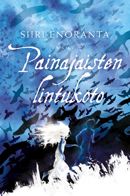 Painajaisten lintukoto
Painajaisten lintukoto
[Sweet haven of nightmares]
Helsinki: WSOY, 2012. 330 pp.
ISBN 978-951-0-38932-4
€26.90, hardback
Siiri Enoranta’s debut novel, Omenmean vallanhaltija (‘The Ruler of Omenmea’, Robustos, 2009) was nominated for the Finlandia Junior award, while another of her novels, Gisellen kuolema (‘The death of Giselle’) was nominated for the Runeberg Prize. Painajaisten lintukoto marks a departure from the genre Enoranta had focused on in her previous works. Her books incorporate the joy of spellbinding, spontaneous fantasy and skill at creating ever more uncanny settings. This novel is situated in the vacillating borderlands between sleep and the waking world. Lunni is a teenage boy who has been set a challenging task of overcoming nightmares and restoring natural sleep to people. The boy is joined by Tui, a mechanical girl. Other important figures in the story are giant tame birds that help Lunni and Tui get from place to place. The prose of Siiri Enoranta (1987) is lyrical, but it also contains points of contact for fans of fantasy writing of many different ages.
Translated by Ruth Urbom
Maria Vuorio: Kuningattaren viitta ja muita kiperiä kysymyksiä [The Queen’s cloak and other knotty issues]
19 January 2012 | Mini reviews, Reviews
 Kuningattaren viitta ja muita kiperiä kysymyksiä
Kuningattaren viitta ja muita kiperiä kysymyksiä
[The Queen’s cloak and other knotty issues]
Kuvitus [Ill. by]: Virpi Talvitie
Helsinki: Tammi, 2011. 71 p.
ISBN 978-951-31-6252-8
€ 20.60, hardback
The style of Maria Vuorio’s books demands quiet concentration – but you could get quite hooked on their slow, thoughtful, gentle story-telling. Vuorio carries on the tradition of classic animal fables, following in the footsteps of Hans Christian Andersen, but with a personal twist. She is masterful in describing different emotional states – whether evoking the inner lives of humans or of anthropomorphised animals. Her stories and fairy tales hand the reader a magnifying glass that brings into view even the smallest, most insignificant creature or thing. The entire universe is present in the stories, for example when an earthworm ponders the meaning of life, a bear breaks into the National Museum, or a noxious insect imperils cultural exchange between Finland and Denmark. Talvitie has drawn an allegorical picture for each tale.
Translated by Fleur Jeremiah and Emily Jeremiah
Marja-Leena Tiainen: Kahden maailman tyttö [The girl from two worlds]
18 January 2012 | Mini reviews, Reviews
 Kahden maailman tyttö
Kahden maailman tyttö
[The girl from two worlds]
Helsinki: Tammi, 2011. 261 p.
ISBN 978-951-31-5937-5
€ 26.65, hardback
Marja-Leena Tiainen (born 1951) has dealt with unemployment, immigration, and racism in her works, in ways that are accessible to her young readership. She researches her topics with care. The idea for this book dates back to 2004, when the author made the acquaintance of a Muslim girl who lived in a reception centre in eastern Finland; her experiences fed into Tara’s story. Tiainen’s central theme, ‘honour’ violence in the Muslim community, is surprisingly similar to Jari Tervo’s Layla (WSOY, 2011). Tiainen’s is a traditional story about a girl growing up and surviving, but the novel’s strong points are the authentic description of everyday multiculturalism, and the intensity of the narration. The reader identifies with Tara’s balancing act, which she must carry out in the crossfire of her father’s authority, family tradition, and her own dreams. In spite of everything, the community also becomes a source of security and support for Tara. The narrative arc is coherent and, despite the numerous overlapping time-frames, the tension is sustained right up to the final, conciliatory solution.
Translated by Fleur Jeremiah and Emily Jeremiah
Hannele Huovi & Kristiina Louhi: Jättityttö ja Pirhonen [The giant girl and Mr Pirhonen]
17 January 2012 | Mini reviews, Reviews
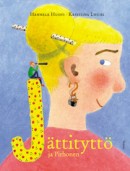 Jättityttö ja Pirhonen
Jättityttö ja Pirhonen
[The giant girl and Mr Pirhonen]
Kuvitus [Ill. by]: Kristiina Louhi
Helsinki: Tammi, 2011. 31 p.
ISBN 978-951-31-5852-1
€ 19.95, hardback
Hannele Huovi and Kristiina Louhi, two eminent professionals in the field of children’s literature, have been collaborating for a long time. Their mutual trust is reflected in the way they grant each other artistic freedom, at times submitting to the text, at others to the illustrations. The depiction of the love story between a giant girl and a tiny man was an exceptional challenge for the illustrator; Tyyne’s tears nearly drown her tiny friend, and to see him properly, she needs a magnifying glass! Louhi has again kept her style economical, and she boldly paints large expanses of colour and forms. Alongside the unequal but happy love story, this picture book deals with tolerance. Tyyne’s enormous size effectively manifests her feeling that she is an outsider. The book also advocates a relaxed attitude to life and the avoidance of unnecessary strain. The example of the giant girl helps the reader to develop a sense of proportion and to realise the value of the everyday.
Translated by Fleur Jeremiah and Emily Jeremiah
Annika Luther: De hemlösas stad [The city of the homeless]
17 January 2012 | Mini reviews, Reviews
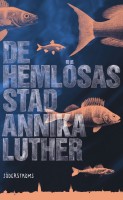 De hemlösas stad
De hemlösas stad
[The city of the homeless]
Helsingfors: Söderströms, 2011. 237 p.
ISBN 978-951-522-846-8
€ 21.10, paperback
Kodittomien kaupunki
Suomennos [Translation from Swedish into Finnish]: Asko Sahlberg
Helsinki: Teos, 2011. 240 p.
ISBN 978-951-851-404-9
€ 33.10, paperback
Annika Luther’s novel is an example of the popular genre of dystopia. Its ecocritical overtones prompt radically new ways of thinking about the effects of climate change. In 2050, the bulk of the earth’s surface is under water, and people from various corners of the earth have been evacuated to Finland. The majority of the residents in Helsinki are Indian and Chinese. Finns are in the minority, and most of them are hopelessly addicted to alcohol. Fifteen-year-old Lilja lives in the city of Jyväskylä with her family, in a protected and tightly controlled neighbourhood. She becomes interested in her family history and decides to find out about her aunt, a marine biologist who remained in flooded Helsinki. Gradually, the mysteries of the past open up to her. The novel is about survival and adaptation. Luther is an original writer, uncompromising in her ethical stance. As in her previous novel, Ivoria (2009), she describes Helsinki with affection: despite the ruined landscape, the city maintains its proud bearing.
Translated by Fleur Jeremiah and Emily Jeremiah
Leena Krohn: Auringon lapsia [Children of the sun]
16 January 2012 | Mini reviews, Reviews
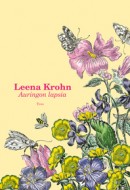 Auringon lapsia
Auringon lapsia
[Children of the sun]
Kuvitus [Ill. by]: Inari Krohn
Helsinki: Teos, 2011. 32 p.
ISBN 978-951-851-311-0
€ 29.40, hardback
It is great news that Leena Krohn has not abandoned the young readership she first addressed through her first book Vihreä vallankumous (‘The green revolution’, 1970), an ecocritical title that also touched on active citizenship. This novel, too, is about the encounter between man and nature. Ten-year-old Orvokki (Violet) is a delivery girl for a florist; like her, the reader is incited to marvel with naive curiosity at life’s various wonders. Krohn is supremely good at writing literature that knows no age limits. Nothing here will go over a child’s head; the essence of the book is accessible to all. In this nicely old-fashioned children’s novel the measured language and expression are pleasing both to the eye and the ear. The hand-coloured graphic prints by the artist (and writer’s sister) Inari Krohn are a homage to Maria Sibylla Merian (1647–1717), the German natural scientist and illustrator who produced life-like paintings of insects and plants.
Translated by Fleur Jeremiah and Emily Jeremiah
Tuuve Aro: Korson purppuraruusu [The purple rose of Korso]
16 January 2012 | Mini reviews, Reviews
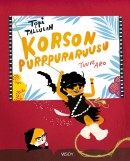 Korson purppuraruusu
Korson purppuraruusu
[The purple rose of Korso]
Kuvitus [Ill. by]: Sanna Mander
Helsinki: WSOY, 2011. 109 p.
ISBN 978-951-0-38052-9
€ 25.70, hardback
Sometimes a book’s appearance is enough to win the reader over. The first children’s novel by writer and film critic Tuuve Aro (born 1973) encourages the belief that things will work out for the best. The book’s positive undertones are also reflected in Mander’s fresh illustrations, which exude retro-nostalgia for the 1950s and 1960s in shades of orange, black, and brown. Tallulah, a jungle princess, turns up unexpectedly to sort out the complicated affairs of Topi, a schoolboy who is being bullied. Tallulah comes into the suburb of Korso from the silver screen, out of Woody Allen’s film The Purple Rose of Cairo. The jungle princess helps Topi to see the bleak suburb as an exotic habitat where adventures are waiting just round the corner. The adult reader gets to enjoy a few carefully chosen references to major cinematic landmarks. Aro eschews problem-centred realism and angst, even though the children’s problems are an indirect result of decisions taken by adults. The Tallulah figure incorporates a hefty dose of anarchy, familiar from Astrid Lindgren’s Pippi Longstocking.
Translated by Fleur Jeremiah and Emily Jeremiah
Once upon a time…
13 January 2012 | Articles, Non-fiction
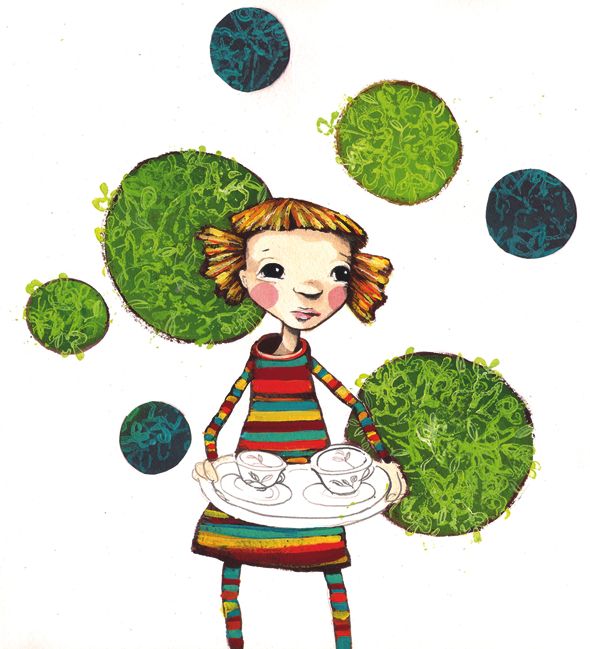
Sari Airola's illustration in Silva och teservisen som fick fötter (‘Silva and the tea set that took to its feet’, Schildts) by Sanna Tahvanainen
The future of book publishing is not easy to predict. Books for children and young people are still produced in large quantities, and there’s no shortage of quality, either. But will the books find their readers? Päivi Heikkilä-Halttunen takes a look at the trends of 2011, while in the review section we’ve picked out a selection of last year’s best titles
The supply of titles for children and young adults is greater than ever, but the attention the Finnish print media pays to them continues to diminish. Writing about this genre appears increasingly ghettoised, featuring only in specialist publications or internet chat rooms and blogs.
Yet, defying the prospect of a recession, Suomen lastenkirjakauppa, a bookshop specialising in children’s literature, was re-established in central Helsinki in autumn 2011, following a ten-year break. Pro lastenkirjallisuus – Pro barnlitteraturen ry, the Finnish society for the promotion of children’s literature, has been making efforts to found a Helsinki centre dedicated to writing and illustration for children. The society made progress in this ambition when it organised a pilot event in May 2011. More…
Sanna Tahvanainen & Sari Airola: Silva och teservicen som fick fötter [Silva and the tea set that took to its feet]
13 January 2012 | Mini reviews, Reviews
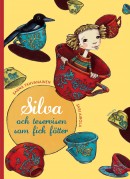 Silva och teservicen som fick fötter
Silva och teservicen som fick fötter
[Silva and the tea set that took to its feet]
Kuvitus [Ill. by]: Sari Airola
Helsingfors: Schildts, 2011. 32 p.
ISBN 78-951-50-2053-6
€ 21.20, hardback
Silva ja teeastiasto joka sai jalat alleen
Suomennos [Translation from Swedish into Finnish]: Jyrki Kiiskinen
Helsinki: Schildts, 2011. 32 p.
ISBN 978-951-50-2054-3
€ 21.20, hardback
Sari Airola’s ability to depict different emotions makes her one of the most interesting Finnish illustrators of children’s books. Airola has long lived in Hong Kong and one can often sense an oriental spirit in her work. In this book, she makes use of Asian textile printing plates to enliven the surfaces of the images. The subject of this debut children’s book by Tahvanainen (born 1975), who is also a poet and novelist, evokes empathy with family situations that deviate from the norm. Silva lives in a big house with her mother, an isolated control freak and migraine sufferer. When her mother suffers an episode, Silva is unable to establish any contact with her and feels insecure. Although the text is allegorical, the book’s message, which concerns a parent’s caring responsibilities and a child’s need to be loved, remains accessible to children. Once the migraine attack is over, the mother goes out to look for Silva; mother and daughter are reconciled when Silva, at last, puts her fears into words.
Translated by Fleur Jeremiah and Emily Jeremiah
Vilja-Tuulia Huotarinen: Valoa valoa valoa [Light light light]
13 January 2012 | Mini reviews, Reviews
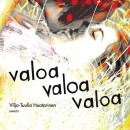 Valoa valoa valoa
Valoa valoa valoa
[Light light light]
Hämeenlinna: Karisto, 2011. 125 p.
ISBN 978-951-23-5433-7
€ 19.95, paperback
Vilja-Tuulia Huotarinen’s novel for young adults demonstrates the author’s familiarity with classic books for girls, her skill in plotting, and, above all, her respect for youth on its own, unique terms. The novel is set in the summer and autumn of 1986. A nuclear explosion occurs at Chernobyl, Ukraine, in spring, and the fall-out worries 14-year old Mariia, who lives on the outskirts of Turku. She befriends Mimi, who has a dark secret in the attic. The friendship between the two girls soon deepens into love, and is described by Huotarinen (born 1977) beautifully and openly. Huotarinen’s language is colloquial, but nevertheless highly lyrical. Valoa valoa valoa promises a revival in the Finnish novel for young adults; it does not wallow in youthful angst or ‘issues’, although the story touches on these things, too. Self-conscious narration, metafiction, adds another intriguing twist to the story.
Translated by Fleur Jeremiah and Emily Jeremiah
Sari Peltoniemi: Kissataksi [Cat taxi]
4 February 2011 | Mini reviews, Reviews
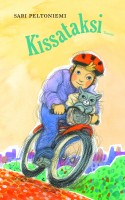 Kissataksi
Kissataksi
[Cat taxi]
Kuvitus [ill. by]: Liisa Kallio
Helsinki: Tammi, 2010. 154 p.
ISBN 978-951-31-5243-7
€16, hardback
Children’s novels with a humane, everyday approach like that of Kissataksi are few and far between. Juho is a skinny eight-year-old boy with a perfect life: pleasant parents, a nice little brother and a dog called Rekku. But one day, he comes across seven cats and an old biddy – and find that the cats have a plan to alleviate her gloom. Juho finds himself driving a taxi for the cats, who are searching for a reliable carer for their mistress, and soon Juho is joined by Virsu, a punk girl. Kissataksi charms the reader with its genial child’s pace. Understanding of displaced people, and empathy in general, have been sadly lacking in children’s literature in recent years. The title of this book is a homage to the Japanese master animator Hayao Miyazaki’s film My Neighbour Totoro, in which a cat bus figures significantly. As in Peltoniemi’s previous novels for children and young people, there is a pinch of magic in this book.
Translated by Ruth Urbom
Reetta Niemelä & Salla Savolainen: Sinisen kärpäsen sirkus ja muita runoja [The blue fly circus and other poems]
3 February 2011 | Mini reviews, Reviews
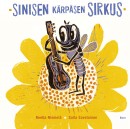 Sinisen kärpäsen sirkus ja muita runoja naapurinötököistä
Sinisen kärpäsen sirkus ja muita runoja naapurinötököistä
[The blue fly circus and other poems about neighbourhood creepy-crawlies]
Kuvitus [Ill. by]: Salla Savolainen
Helsinki: Otava, 2010. 40 p.
ISBN 978-951-1-24002-0
€20, hardback
Reetta Niemelä has provided a breath of fresh air in Finnish children’s poetry with her collections Makkarapiruetti (‘Sausage pirouette’, 2005) and Kakaduu (‘Cockatooo’, 2009), whose onomatopoeic sounds and whimsical grammar are reminiscent of children’s language play as they learn to speak. This book opens up the secrets of the world of earthworms and the tiniest of insects to the reader, revealing natural wonders at (literally) grass-roots level. The most delightful aspect, however, is to be found in its illustrations: Salla Savolainen employs a painstaking, richly nuanced woodcut technique, which puts a natural finishing touch to the collection. This sort of delicacy has not been seen in children’s book illustration in a very long time! Savolainen’s images seem light, breezy and lively – each little bug has its own charismatic personality.
Translated by Ruth Urbom
Timo Parvela & Jussi Kaakinen: Taro maan ytimessä [Taro at the centre of the Earth]
3 February 2011 | Mini reviews, Reviews
 Taro maan ytimessä
Taro maan ytimessä
[Taro at the centre of the Earth]
Kuvitus [Ill. by]: Jussi Kaakinen
Helsinki: WSOY, 2010. 24 p.
ISBN 978-951-0-36718-6
€22, hardback
Illustrator Jussi Kaakinen (born 1978) is known for, among other things, his illustrations for the graphic novel version of Risto Isomäki’s sci-fi work Sarasvatin hiekkaa (‘The sands of Sarasvati’, 2008) and two children’s non-fiction books, Suomen lasten historia (‘A Finnish children’s history’, 2005) and Suomen lasten taidehistoria (‘A Finnish children’s art history’, 2009). Taro maan ytimessä is his first picture book in his own right. Kaakinen employs an experimental illustration style here, borrowing from comic book techniques, to create an appropriately fast-paced text. The children in the story are curious to find out whether they can dig deep enough in their sandbox to reach the other side of the world. Taro has a bear for a friend who constructs a machine out of old junk that can dig into the Earth and then into outer space. On their daredevil journey, the pair encounter a greedy monster worm with a sweet tooth. Their adventure ends when Taro returns home, although the space worm, making a racket in the sewers, ought to be hidden from his parents…. Taro maan ytimessä is a pacey, visually striking adventure that will be especially enthralling to boys.
Translated by Ruth Urbom
Laura Lähteenmäki: Aleksandra Suuri [Alexandra the Great]
1 February 2011 | Mini reviews, Reviews
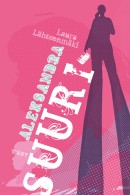 Aleksandra Suuri
Aleksandra Suuri
[Alexandra the Great]
Helsinki: Tammi, 2010. 180 p.
ISBN 978-951-0-36522-9
€18, hardback
Laura Lähteenmäki’s novel for young people is a rare, rollicking tale of independence whose treatment of even heavy topics is guaranteed to make readers laugh, sometimes through their tears. Tim, a Dutch exchange student, shakes things up in 16-year-old Alexandra’s family when he comes to stay. She is used to being the centre of attention in her family and circle of friends, but self-confident Tim brings Alexandra’s status into question. As in her previous novels for young people, Laura Lähteenmäki presents a briskly paced drama of interpersonal relationships. Events are filtered through Alexandra’s eyes as the first-person narrator. Readers can easily get behind her point of view: Tim is truly a jerk. The portrayal of complex family relationships following a traumatic divorce makes this book worthwhile reading for adults as well, even if Lähteenmäki does resort to somewhat clichéd solutions in her portrayal of minor adult characters.
Translated by Ruth Urbom
